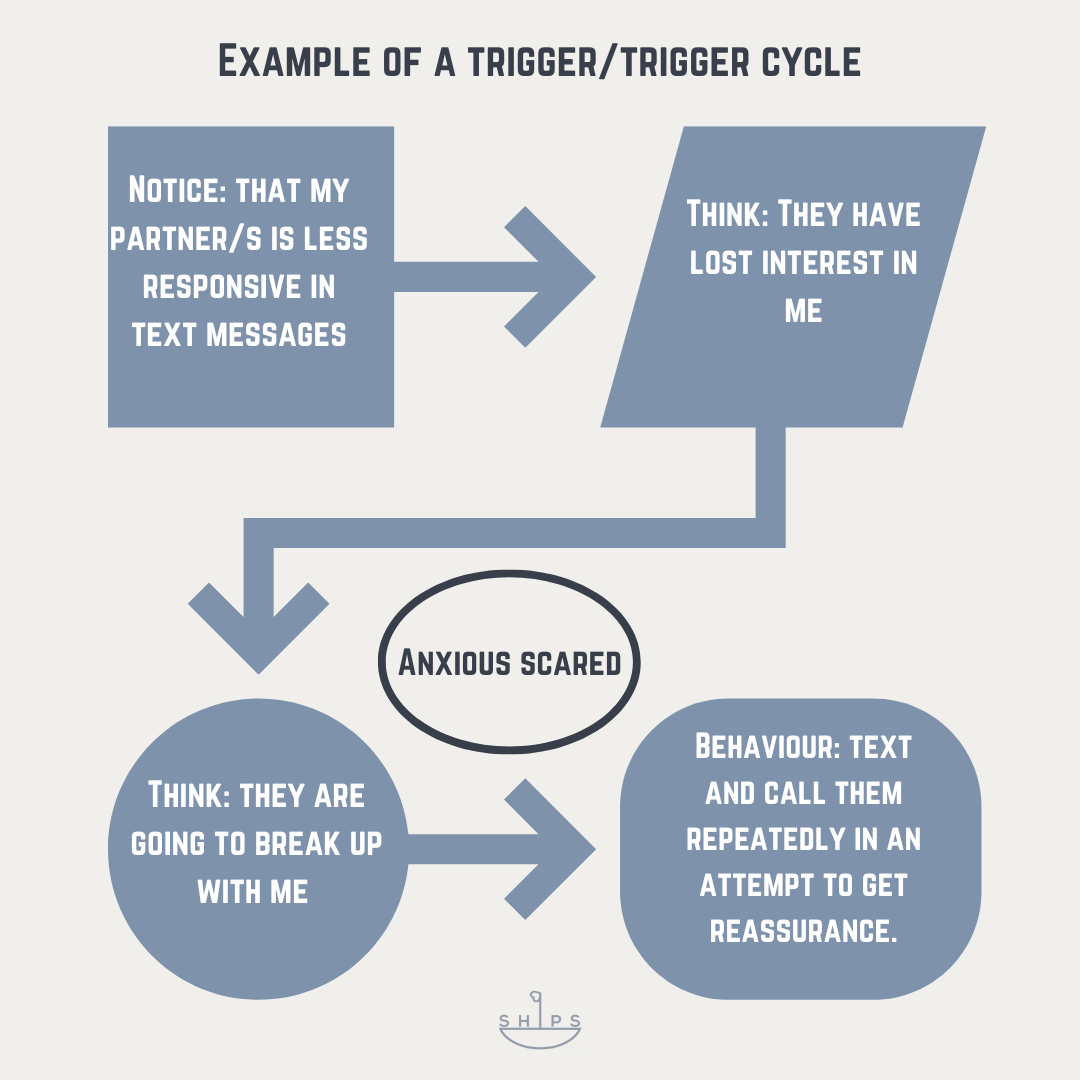Anxious attachment: What can healing in a relationship look like for you?
Our attachment style describes the way we have learnt to meet out needs in relation to others. We learn this during our early experiences with a caregiver and this forms the blueprint for how we function in in adult relationships.
Anxious attachment involves a high level of preoccupation with (and anxiety around) our partner/s behaviour. We take on all the responsibility for seeking out and maintaining our needs and ultimately we don’t really trust in the reliability or the relationship (ourselves).
Understand your triggers & cycle
If you are anxiously attached, there will be particular internal or external triggers that will provoke a cycle of anxious thoughts, feelings and behaviour.
Eg. Notice that my partner/s is less responsive in text messages -> Think: They have lost interest in me ->Think they are going to break up with me -> Anxious scared -> Behaviour: text and call them repeatedly in an attempt to get reassurance.
Notice what it feels like when you are triggered
To build new patterns, it is first necessary to notice when the old ones are repeating themselves.
To help notice when you are triggered, try to identify the sensation in your body that arises.
Eg. Aching in the chest, racing heart, foggy head.
When these feelings come up in your body it is a signal that you might be triggered, so you can take some steps to get out of the cycle.
Understanding where they come from
If you have an anxious attachment style as an adult, then it is useful to identify the experience that led to this as a child eg. lack of availability from a caregiver, and lack of responsiveness to your emotions.
Recognising where the attachment style helps you to link the trigger & the cycle to the real sources.
Your partner/s behaviour might have triggered the cycle, but the cycle and all the thoughts, feelings and behaviour that is connected to it, is an adaptation from your early experiences. The fear is connected to the past, not to the current circumstances.
Learning to ground & self-soothe
If you are able to notice you are triggered, the only helpful thing you can do at this moment is to ground yourself. If you are triggered you can’t see the situation or your partner clearly. Soothing the fear is also important and it can help you to learn to do this yourself rather than relying on your partner/s.
Ways that you can ground:
Notice 5 things you can see, 4 things your can touch, 2 things you can hear
Splash your face with cold water
Go for a walk
Take some long deep breaths
Ways that your can self soothe:
Soothing touch - touch your chest, tummy or face in a way that feels reassuring
Wrap yourself up in a blanket
Make yourself a cup of tea
Listen to a self-compassion meditation
Build a new relationship blueprint
Once you are able to recognise the old cycle and ground yourself, it is time to start replacing this with a new blueprint for a healthy relationship. This includes thoughts, feelings and behaviours that help you to have secure attachments
Examples:
Notice: My partner/s is on my team, we will solve this together
Feeling: Notice the times that you feel at peace and safe with your partner/s and work to create this more often
Behaviour: Approaching partner/s with love & openness when asking a question
Image made by Mikaela - Event & Communication Assistant
This blog post is a brief exploration of this topic and do not replace therapy. At SHIPS, we have practitioners that are knowledgeable and skilled in a variety of areas including sex therapy, relationships and more. If you may benefit from some support, please check out our website resources, or contact us.
We are also always happy to hear feedback about our blog articles. If you would like to share your experience or feel we may have missed something on this topic, please contact us to let us know.
How can SHIPS support you?
AUTHOR
Dr. Sarah Ashton, PhD
Director & Founder of Sexual Health and Intimacy Psychological Services (SHIPS)








